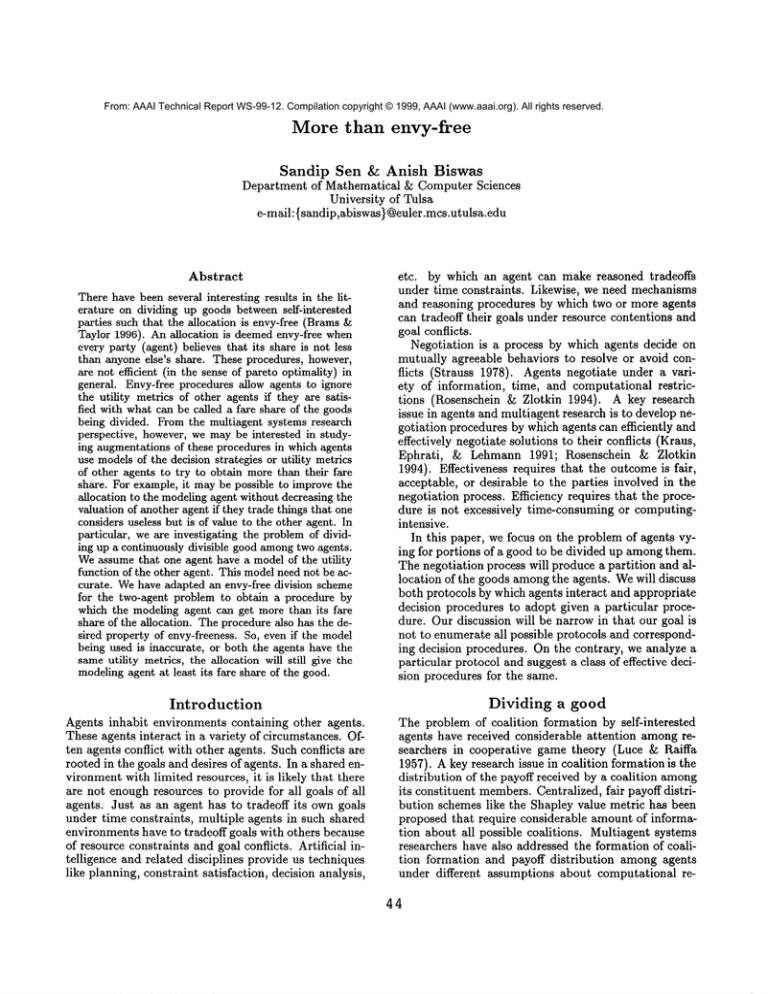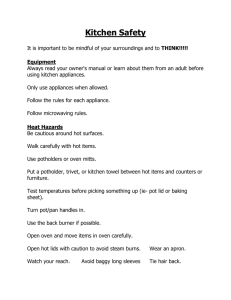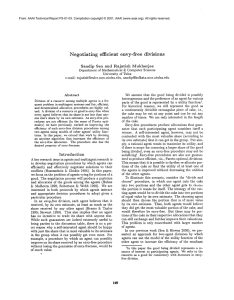
From: AAAI Technical Report WS-99-12. Compilation copyright © 1999, AAAI (www.aaai.org). All rights reserved.
More than envy-free
Sandip Sen &: Anish Biswas
Department of Mathematical &5 Computer Sciences
University of Tulsa
e-mail: {sandip,abiswas} @euler.mcs.utulsa.edu
Abstract
There have been several interesting results in the literature on dividing up goods betweenself-interested
parties such that the allocation is envy-free (Brams
Taylor 1996). An allocation is deemedenvy-free when
every party (agent) believes that its share is not less
than anyone else’s share. These procedures, however,
are not efficient (in the sense of pareto optimality)
general. Envy-free procedures allow agents to ignore
the utility metrics of other agents if they are satisfied with what can be called a fare share of the goods
being divided. Fromthe multiagent systems research
perspective, however, we maybe interested in studying augmentationsof these procedures in which agents
use modelsof the decision strategies or utility metrics
of other agents to try to obtain more than their fare
share. For example, it maybe possible to improve the
allocation to the modelingagent without decreasing the
valuation of another agent if they trade things that one
considers useless but is of value to the other agent. In
particular, we are investigating the problemof dividing up a continuously divisible goodamongtwo agents.
Weassume that one agent have a model of the utility
function of the other agent. This modelneed not be accurate. Wehave adapted an envy-free division scheme
for the two-agent problem to obtain a procedure by
which the modeling agent can get more than its fare
share of the allocation. The procedurealso has the desired property of envy-freeness. So, even if the model
being used is inaccurate, or both the agents have the
sameutility metrics, the allocation will still give the
modelingagent at least its fare share of the good.
etc. by which an agent can make reasoned tradeoffs
under time constraints. Likewise, we need mechanisms
and reasoning procedures by which two or more agents
can tradeoff their goals under resource contentions and
goal conflicts.
Negotiation is a process by which agents decide on
mutually agreeable behaviors to resolve or avoid conflicts (Strauss 1978). Agents negotiate under a variety of information, time, and computational restrictions (Rosenschein & Zlotkin 1994). A key research
issue in agents and multiagent research is to develop negotiation procedures by which agents can efficiently and
effectively negotiate solutions to their conflicts (Kraus,
Ephrati,
& Lehmann 1991; Rosenschein & Zlotkin
1994). Effectiveness requires that the outcomeis fair,
acceptable, or desirable to the parties involved in the
negotiation process. Efficiency requires that the procedure is not excessively time-consuming or computingintensive.
In this paper, we focus on the problem of agents vying for portions of a good to be divided up amongthem.
The negotiation process will produce a partition and allocation of the goods amongthe agents. Wewill discuss
both protocols by which agents interact and appropriate
decision procedures to adopt given a particular procedure. Our discussion will be narrow in that our goal is
not to enumerate all possible protocols and corresponding decision procedures. On the contrary, we analyze a
particular protocol and suggest a class of effective decision procedures for the same.
Dividing a good
Introduction
Agents inhabit environments containing other agents.
These agents interact in a variety of circumstances. Often agents conflict with other agents. Such conflicts are
rooted in the goals and desires of agents. In a shared environment with limited resources, it is likely that there
are not enough resources to provide for all goals of all
agents. Just as an agent has to tradeoff its owngoals
under time constraints, multiple agents in such shared
environments have to tradeoff goals with others because
of resource constraints and goal conflicts. Artificial intelligence and related disciplines provide us techniques
like planning, constraint satisfaction, decision analysis,
The problem of coalition formation by self-interested
agents have received considerable attention amongresearchers in cooperative game theory (Luce & Raiffa
1957). A key research issue in coalition formation is the
distribution of the payoff received by a coalition among
its constituent members.Centralized, fair payoff distribution schemes like the Shapley value metric has been
proposed that require considerable amount of information about all possible coalitions. Multiagent systems
researchers have also addressed the formation of coalition formation and payoff distribution among agents
under different assumptions about computational re-
44
source and knowledge limitations (Sandholm & Lesser
1995; Shehory & Kraus 1995).
In the following, we will discuss a related problemand
some possible approaches to solving it. The problem
is that of dividing up a good (this can be a payoff to
a coalition, but not necessarily so) between multiple
individuals. Wewill assume that the solution procedure
is of a decentralized nature. This means that the agents
will be required only to abide by a protocol by which
the division is to be made. They can freely choose any
strategy to use to determine their actions within the
accepted protocol.
For example, a protocol might be that every agent
submits a sealed bid for the good. After every bid is
collected, the good is divided up amongthe bidders in
proportion to their bids. Our assumption is that once
the agents agree to such a protocol, they are free to
choose their bids following any strategies they adopt.
Werequire, however, that agents will agree to the division of the good as specified once they have placed
their bids.
Froma designer’s point of view, the choice of a protocol provides a platform for agents to negotiate an agreeable division. The choice of a strategy will be dictated
by concerns for arriving at a preferred share of the good
being divided. The protocol designer should then provide protocols which can be used by agents to successfully negotiate agreeable divisions with reasonable computational costs. Wewill nowlook at properties of divisions that can make them agreeable to self-interested
agents.
Efficiency: A solution is said to be Pareto optimal or
efficient if there is no other partition which will improve the perceived share of at least one agent without decreasing the perceived share of any other agent.
Here are some observations on the above-mentioned
metrics:
¯ If all agents have identical perception or utility function, any partition is efficient. Also, in this case the
only proportional solution is also envy-free and equitable.
¯ For two agents, proportionality implies envy-freeness.
This implication, however, does not hold for arbitrary
n. For example, an agent can believe it has got more
than its fare share, but can still be envious of another
agent which it believes has received an even larger
share.
Improving
on envy-freeness
Envy-free procedures produces allocations with desirable characteristics.
The solutions generated by such
procedures guarantee that everyone considers itself a
winner. While such guarantees are indeed extremely
useful to bring parties to the discussion table, often a
self-interested
agent may want more. There is no reason a priori to justify whya self-interested agent should
be happy with just the largest share in the group when
it can possibly get even more. Put simply, a rational
agent wants to maximizeits utility, and if there is scope
for cornering a larger share of the good being divided,
even an envy-free procedure may not be satisficing!
For example, a procedure by which an agent can posSibly improve on its share received by an envy-free procedure without losing the guarantee of envy-freeness,
would be extremely attractive.
The question then is
what information needs to be known about others for
an agent to corner a larger than envy-free share.
Thoughit can be practically possible for a rational
agent to risk losing the envy-free guarantee in the hope
of gaining substantial benefit most of the time, we will
not pursue this line of investigation in the current paper. For the rest of the paper, we concentrate exclusively on dividing a good between two agents. Weassume that the good being divided is possibly heterogeneous and the preference of an agent for various parts
of the good is represented by a utility function. For
historical reasons and to expedite the description of the
procedures we have adapted from literature, we will represent the good as a rectangular piece of cake. Actually
for all practical purposes, we are only interested in the
length of the cake. In the following, and unless otherwise noted, we will assume the good to be continuously
divisible.
Wewant to develop procedures that are resistant to
spiteful agents. That is even if the agent being modeled
realizes that the other agent is trying to exploit a model
of its utility function, it cannot force a division that
hurts itself but achieves the goal of making the modeling agent envious too. To illustrate a procedure without
Desired characteristics
of divisions
As mentioned before, we assume that a single divisible
good is to be divided among n agents. Any number of
decision procedures can be adopted to make the division of the whole into parts and subsequently allocate
the parts to different agents. Wewill be interested in
evaluating both decision procedures or protocols which
agents agree to abide by for making the division, as
well as the strategies used by the agents to decide their
negotiation behavior once the protocols have been decided.
The following criteria has been espoused by various
researchers to be desirable characteristics of decision
procedures or outcomes from such procedures (Brams
& Taylor 1996):
Proportionality: Each agent believes that it received,
by its own estimate, at least ~ of the goods being
allocated.
Envy-free: Each agent believes that it received, by its
own estimate, at least as muchas the share received
by any other agent. This also implies that an agent
has no incentive to trade its share with anyone else.
Equitable: A solution, i.e., a partition of the good
amongthe n agents, is equitable, when the share received by each agent is identical in terms of their
individual utility functions.
45
Moving
half of the cake in its estimate. If this player waits any
longer, it risks losing more than half of the cake if the
other player calls cut! Note that the above-mentioned
strategy does leave open the possibility that the player
calling cut will think that the other player, say B, also
thinks that it, i.e., B, got morethan half of the cake by
B’s estimate. This, however, should not lead to envy.
Envy-freeness only requires that each player thinks that
it got at least the largest share by its own estimate.
Thus each player may believe that it got the largest
share. This will be true in general except in the special
cases where one or both players think that they got
exactly half of the cake.
Nowwe analyze this procedure for efficiency. Suppose that agent A calls cut and gets the portion to the
left of the knife. It mightbe the case that there is a portion immediately to the right of the knife that has no
utility in the view of agent B, but is of value to agent A.
This region can be transferred to agent A, thereby increasing its utility. At the same time this transfer does
not reduce the utility of agent B. Thus the strategy
to guarantee envy-free division in the Austin’s moving
knife procedure does not guarantee efficiency.
Wenow present a strong result that eliminates the
hope of producing optimal divisions in general for continuously divisible goods.
Theorem 1 There does not exist an algorithm that
guarantees an efficient division of continuously divisible good between two agents.
Proof: Our proof involves generating a problem scenario for which finite decision mechanisms to generate optimal allocations do not exist. Consider the
scenario where the continuously divisible good can be
divided into infinitely manypieces such that any two
neighboring pieces have the property that the first
piece is valued by one agent and is of no value to the
other agent and the opposite holds true for the second piece. To produce an optimal allocation in this
case requires infinitely manycuts of the cakes. As
such, no finite procedure or algorithm can produce
an optimal allocation in this situation.
knife
Figure 1: Austin’s moving knife procedure.
such a guarantee consider the "divide and choose" procedure, in which one agent cuts the cake into two halves
and the other agent gets to choose which half it wants
for itself. In the non-modeling case, the basic strategy of the cutting agent will be to divide the cake into
two equal halves, so that it is envy-free irrespective of
which half the other agent chooses. The choosing agent
chooses whicheverhalf it considers is larger, or at least
as large as the other one, and thus is envy-free too. The
choosing agent, however, may believe that the cutting
agent is using a modelof its utility function to makean
unequal cut from the cutting agent’s perspective and
is hoping to pocket larger than its estimate of half of
the cake. A spiteful choosing agent may choose to hurt
both itself and the cutting agent by choosing the part
it considers smaller by its estimate and is bigger by the
estimate of the cutting agent.
The utility to the ith agent of a piece of the cake
cut between points a and b (where a < b) is given
f:ui(x)dx, where Us(x)is the utility function of the
ith agent. Without loss of generality, we will assume
that the first agent is having a model, U2, of the utility
function of the second agent. This model need not be
accurate, but the better the model, the more benefit
the modeling agent stands to gain by using it.
An envy-free
procedure
Division procedures will, in general, have two components: a rule set to be followed in arriving at an allocation, and strategies to be used by the players to obtain fair shares. For example, in the above-mentioned
"divide and choose" scheme, the procedure is that one
player divides the cake, and the other gets to choose the
part it wants. Within this procedure, a strategy that
guarantees envy-freeness is as follows: the divider divides the cake into half by its estimate, and the chooser
chooses the part that it considers to be at least as big
as the other part.
Wefirst narrate Austin’s moving knife procedure for
arriving at an envy-free division of a cake (Austin 1982).
A referee moves a knife to the right starting from the
left edge of the cake and always keeps the knife parallel
to that edge (see Figure 1). At any time, either player
can call "cut". Whenone player makes such a call, it
gets the portion of the cake to the left of the knife, the
other part going to the other player. To guarantee envyfreeness, a player has to call "cut" if the portion of the
cake to the left of the knife becomesat least as large as
Using
to obtain
a larger
share
Weallow agent A to use an approximate model, UB, of
the utility function of the agent B. The actual utility
functions of the two agents are UAand UBrespectively.
In our procedure, the modeling agent start by holding
two knives parallel to the side edges of the cake (see
Figure 2) and then movethem to the right allowing for
wrap around. Let the positions of the left and right
knives at time t be It and rt respectively. The knives
stop when the right knife reaches the original position
of the left knife, and the left knife reaches the original position of the right knife. Noneof the knives are
allowed to move beyond the original positions of the
other knife. Whenthe knives finally stop moving at
time t = T, agent B has seen all the regions that was
46
information
satisfied with just half of the cake by its estimate. But
a contiguous region that satisfy both these conditions
maynot be found in general.
Region allocated to B
Left knife
Initial
region selection
The initial placement (m, n) of the knives should
such that in addition to satisfying Equation 1 it should
also satisfy the following condition:
Right knife
Figure 2: Our augmentation of Austin’s procedure with
the modeling agent moving two knives.
ij0 I
(m, n) = arg min UB(z)dz
offered to it by agent A. It then chooses one of these
regions by specifying a time v < T. The portion of the
cake in between l~ and rr is given to B, with the rest of
the cake going to agent A. If rr < lr, i.e., the right knife
is to the left of the left knife (this can happensince we
allow wrap around), then B gets both the portions between the left knife and the right edge of the cake and
from the left edge of the cake to the right knife. We
allow B to see the entire process before deciding what
region to choose as a partial counter-measure to the
advantage that A has in being the one who moves the
knives. Even then, the procedure remains asymmetric.
It does not mean, however, that A can necessarily gain
at the expense of B. Rather, the goal here is to find
allocations that dominate those obtained with Austin’s
procedure.
Given the above rules, what should be the strategy
of the modeling agent? Its goal is to give B just enough
to makeit envy-free. Intuitively, A should try to give B
half of the cake according to B’s estimate while giving
up as little as possible of what it values.
On first thought, then, A should start with the left
and right knives at the positions for which the intermediate part is least useful for A ands the same part is
most wanted by B. But this will not guarantee envyfreeness for A. To see why this is the case let m and
n be the initial positions of the left and right knives.
Now,it may be the case, that B calls cut immediately
or never calls cut. In the first case, A gets a part of
the cake of utility f~ UA(x)dx; in the second case, A
gets a part of the cake of utility J~ UA(x)dx (for ease
of exposition, if y < x, we use J~ f(z)dz to represent
i.e., the initial allocation is to be as close as possible to
half of the cake according to the B’s estimate. Since A
has only an approximate model of B’s utility function,
the best it can do is to choose the initial placements
such that
Though B can get close to half of the cake by its
estimate at the beginning or the end, someintermediate
offering maybe of more value to it.
Target region selection
Wewill now present an analysis by which the modeling
agent selects the region of the cake that it will most
prefer to offer to B which will still be acceptable to B,
i.e., accepting it will give an envy-free allocation to B.
Such a region delimited by pair of points m and n must
satisfy both of the following inequalities:
UA(x)dx
The first of the above says that A will be envy-free in
giving up the region between m and n, and the second
inequality says that B will be envy-free in receiving that
region. Put together, these inequalities identify regions
which A will prefer to give up assuming that B will not
accept a non-envy-free share. A slight enhancement,
eliminates the beginning and end regions to return the
following set of point pairs (each point pair defines
region or possible allocation):
z = ((x,u):
= -~ UA(x)dx,
< -~ UA(x)dx,
/._uB()e ___IZ _
fp~ef(x)dx
f(z)dz). thatSince
these two envy-freeness,
parts are commentary,÷itf~ follows
to guarantee
the initial knife placements should be such that they
divide the cake exactly in half by A’s estimate. So, the
initial knife placements should be such that
UA(x)dx
- ~ UB(z)dz
(1)
f/
> max
J lo
° f,i
f/
^( U (z)d < 7
where L is the length of the cake.
It is also desirable that the initial knife placementsbe
such that the region in between does divide the cake in
half for agent B. Otherwise it will call cut immediately
or mayget more than proportional share by waiting until the end. In either case, A will not be able to exploit
its model of B’s utility function and would have to be
Fromthe regions in Z, we filter out those regions that
are of least value to A:
Y
Y = arg min
(~,y)ez
4"]
~
UA(z)dz.
0 I
Fromthe regions in Y, A can select those regions which
are estimated to be of most value to B:
(a)
X = arg max-- [u UB(z)dz.
Initial position
(z,y)6Y
The above is a maximinprocedure for selecting regions
that A desires to offer to B. If X is non-empty,then A’s
goal is to select one of its elements and then movethe
knifes such that the corresponding region is the most
attractive offer received by B. If such a procedure for
movingthe knives is followed, B will choose this region
over the initial or final offerings, and A will have succeeded in makinguse of its modelof B’s utility function
to obtain a larger than equal share. If X is empty, however, A will have to be satisfied with half of the cake.
(b)
IL
i
R
(c)
I
R
Moving the knives
While moving between pairs of points as identified in
the previous paragraph, the knife locations (u, v) should
satisfy the following inequality:
(d)
L
I
R
’
fuv UB(z)dz < l foLUB(x.)dz.
(e)
For regions where A’s utility is high, the spacing between the knives will be reduced to make that region
non-envy-free for B.
Wenow analyze the effects of an inaccurate model
of B’s utility function as used by A. By enforcing the
constraint that at no time during the procedure the
region between the two knives is greater than half the
cake’s worth in A’s estimate, we have eliminated the
possibility of a division which is non-envy-free for A.
The worst case scenario is that A receives exactly half of
the cake in its estimate. Interestingly, this wouldalso be
the result if both agents have identical utility functions
irrespective of whether A has an accurate model of B’s
utility function.
At this point, we have completed a coarse description
of a procedure to be followed by our modeling agent to
exploit its model of the other agent. Another way of
looking at the above description is a characterization of
a class of strategies that guarantees envy-freeness but
can provide a significantly larger share of the cake than
that obtained by Austin’s moving knife procedure.
Final position
Figure 3: A procedure for knife movementto take advantage of a modelof the other agent’s utility function.
2. The left knife is moved right, allowing for wraparound, until it coincides with the left edge of region
G (see Figure 3(5)).
3. The right knife is moveduntil it coincides with the
right edge of region G (see Figure 3(c)).
4. The left knife is moveduntil it coincides with the
initial position of the right knife (see Figure 3(d)).
5. The right knife is moveduntil it coincides with the
initial position of the left knife (see Figure 3(e)).
The only three regions that can be chosen by a rational B is the initial offering, the final offering, or region
G. If G belongs to the set of X which is a subset of the
set Z, then G should be preferred over the other two
choices. Hence, A will be able to get more than half the
share of the cake by its estimate.
A specific
procedure
Nowwe present a particular instance of these class of
strategies assuming that the set X is non-empty. The
particular procedure we are going to describe is also presented pictorially in Figure 3. Wefirst choose a member
of this set that defines a region G that A wants B to
take. The distinct steps of the procedure are as follows:
1. A should begin by putting its right knife somewhere
inside the region G and the left knife to its right
(allowing for wrap-over, which means that in some
cases, the left knife wouldbe situated to the left of
the right knife to start with) such that the region betweenthese knives satisfies the criteria given in equations 1 and 2 respectively (see Figure 3(a)).
Properties
of the proposed
division
procedure
Wenow present some characterizations
of the of the
decision procedure described above. All of the following
theorems will assume that the model being used of the
other agent is an accurate one, i.e., UB(x) -- UB(X.).
Wewill also assume that B is acting rationally. That
is, it chooses the region whichmaximizesits utility from
the set of regions offered. If B chooses irrationally, A
benefits by getting a larger allocation than expected.
48
Theorem 2 If a Pareto-optimal allocation for a problem involves a contiguous region, our proposed scheme
will select it.
Theorem 5 Our scheme produces Pareto-optimal allocations for rational agents with utility functions with
a single optimum.
Proof" Wewill prove the theorem by contradiction.
Westart by assuming that there exists a contiguous region which when allocated to B produces a
Pareto-optimal allocation. Let our division procedure allocate the region bounded by points (u, v)
agent B. Suppose there exists another contiguous region, bounded by points (p, q) which when allocated
to B produces an envy-free allocation that dominates
the allocation selected by our procedure. This means
that f/UA(x)dx ~_ f: UA(x)dx and f/UB(x)dx
f: UB(x)dx with at least one of the inequalities bemg satisfied in the strict sense. But since maximin
strategy chooses (u, v) over (p, q) then one of the
lowing must be true:
Proof: The Pareto-optimal allocation will be a contiguous region which will be selected by our scheme.
Discussion
Wehave presented a decentralized protocol and a class
of decision strategies to be used by two agents to divide
up a continuously divisible good between them. The
goal of this work is to provide a mechanism by which
an agent can use its knowledge about the preferences
and utilities of the other agent to obtain a larger than
proportional share of the good. The mechanism should
still guarantee envy-freeness for both agents. In the
case of two agents, this would mean that each agent
believes that it got at least half of the good by its own
estimate. As a result, neither agent would be ready to
trade its allocation with the other agent.
Weare working on extending this approach to more
than two agents. The next step would be to augment
the procedurefor the case of three agents. It is unlikely,
however, that such moving knife procedures can be extended for the case of an arbitrary number of agents.
For the general case of n agents, we would be interested in augmenting approximately envy-free division
procedures, where allocations are envy-free within some
pre-specified error-bounds (Brams & Taylor 1996).
1. (p, q) ~ Z, i.e., the allocation is not envy-free for
both agents,
2. (p,q) E Z A (p,q) ¢ Y, i.e.,
f/UA(x)dx
uA(x)dx,
3. (p,q)
e Y A (p,q)
¢ i.e .,
fv qvA(x)dx
=
f: vA(x)dx
^ f/ v.(x)dx<f: VB(x)dx.
This means the allocation to B of the region bounded
by the points (p, q) is either non-envy-free or it does
not dominate the allocation of the region bounded
by the points (u, v). With this contradiction,
conclude that the contiguous region selected is the
Pareto-optimal contiguous allocation.
Theorem 3 Our scheme dominates Austin’s
with respect to efficiency of allocations.
References
Austin, A. 1982. Sharing a cake. Mathematical Gazette
66(437):212-15.
Brams, S. J., and Taylor, A. D. 1996. Fair Division:
From cake-cutting to dispute resolution. Cambridge
University Press, Cambridge: UK.
Kraus, S.; Ephrati, E.; and Lehmann, D. 1991. Negotiation in a non-cooperative environment. Journal
of Experimental and Theoretical Artificial Intelligence
3(4):255-282.
Luce, R. D., and Raiffa, H. 1957. Games and Decisions: Introduction and Critical Survey. NewYork,
NY: Dover.
Rosenschein, J. S., and Zlotkin, G. 1994. Designing
conventions for automated negotiation. AI Magazine
29-46.
Sandholm, T. W., and Lesser, V. R. 1995. Coalition
formation amongbounded rational agents. In Proceedings of the International Joint Conferenceon Artificial
Intelligence, 662-669.
Shehory, O., and Kraus, S. 1995. Task allocation
via coalition formation among autonomous agents. In
Proceedings of the International Joint Conference on
Artificial Intelligence, 655-661.
Strauss,
A.
1978. Negotiations, Varieties, Contexts, Processes, and
Social Order. Jossey-Bass Publishers,San-fransisco.
procedure
Proof: In Austin’s procedure using a knife, division
of the cake is a contiguous one and from theorem 2
we know that any allocation given by Austin’s procedure cannot be more efficient. However, Austin’s
procedure cannot make contiguous allocations such
that a middle part of the cake goes to one agent and
the front and end goes to the other agent. Our procedure can produce that because of we allow the knives
to wrap-around. For situations where allocations of
a contiguous region from the middle of the cake is
necessary, the allocation produced by our procedure
improves on the allocation produced by Austin’s procedure. Thus our procedure dominates Austin’s procedure with respect to efficiency of allocations.
Theorem 4 Our scheme produces Pareto-optimal allocations for rational agents with monotonic utility function.
Proof: Whenutility functions are monotonic for both
agents, the desired region that A wouldlike to give to
B will be a contiguous region at one of the two ends
of the cake. From theorem 2 it follows that such a
contiguous region will be selected by our scheme.
49






